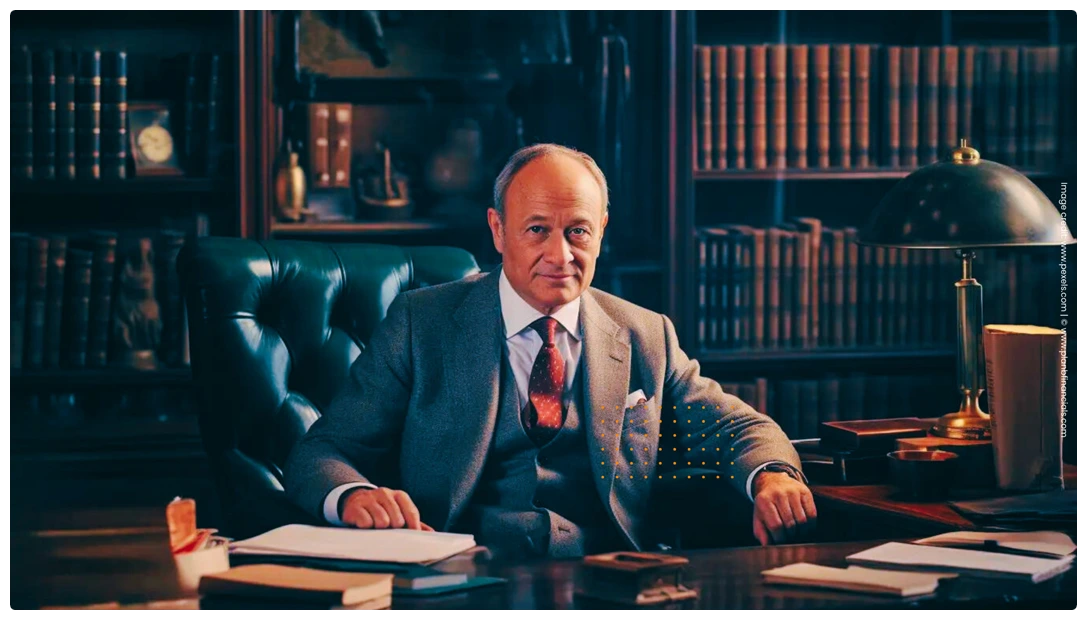The American stock market has a long history filled with successful investors, each leaving a lasting impact on how we approach investing. These investing legends have shaped the way many people see the stock market. In this article, we’ll introduce you to the top ten American investors who have made significant contributions to stock market investing through their knowledge and dedication.
In this Article
ToggleThe Context
The American stock market has a long and continuous history, and as a result, much of the literature, techniques, and ideas related to the stock market are based on the conquests of well-known American investors.

These individuals are considered to be legends who have had a profound influence on many investors and their general perception of the stock market. In this article, we will be showcasing the top ten American investors who have contributed to the advancement of stock market investing through their expertise and dedication.

1. Benjamin Graham
Benjamin Graham is considered the father of value investing and is known for his emphasis on fundamental analysis. This has led to him being ranked as the top legendary American investor on this list. He is particularly credited with introducing the security analysis technique, which is still used today by investors all over the world to assess the relationship between the return and risk of financial securities.
This, in our opinion, places the entire burden of enlightening the world about investment strategy planning on his shoulders. In 1926, Graham founded a business named Graham-Newman Partnership and also began working as a professor at Columbia University, where he taught finance classes at night.
Graham incorporated the knowledge from these classes in his first book, “Security Analysis,” which was published in 1934 and was co-written with one of his former students, David Dodd. The book by Benjamin Graham became the standard for investing, equating it to the prestige of the Bible in the investing sector.
Warren Buffet, a Graham student himself, extolled the virtues of the book after he had achieved significant success in the stock market by basing his decisions on the Security Analysis principles. His notable work, “The Intelligent Investor“, a book published in 1949, made a great impact on the financial world as Security Analysis.
For stock market participants, this book clarified the differences between the concepts of investment and speculation and introduced the ideas of value investing that serve as a key inspiration for our finance blog.
With his revolutionary work analyzing stock market dynamics, Benjamin Graham transformed how people think about and approach investing. For this reason, he is frequently referred to as the “Father of Security Analysis.”
2. Warren Buffett
On our list of the top 10 Legendary American investors, Mr. Warren Buffett, also known as the Oracle of Omaha, takes the second spot. Warren Edward Buffett, an American business tycoon, philanthropist, and investor, was born on August 30, 1930. He presently serves as Berkshire Hathaway’s chairman and CEO.
With a net worth of nearly $100 billion as of November 2022, Mr. Bufett, a man of strong fundamentals and one of the world’s most successful investors, is the sixth-wealthiest person on the planet. He is known for his value investing approach, which involves buying undervalued companies and holding onto them for the long term.
He became interested in business and investment while he was young, eventually enrolling at the University of Pennsylvania’s Wharton School in 1947 before transferring to and graduating from the University of Nebraska at the age of 19.
After graduating from Columbia Business School, he based his investment philosophies on the idea of value investing, which was developed by Benjamin Graham. He enrolled at the New York Institute of Finance to concentrate on his economics training, and soon after, he started working with Graham in several commercial ventures.
Whether they are brief remarks, statements to the press, or letters he sends to Berkshire Hathaway stockholders. Every nugget of wisdom Mr. Buffett imparts is a timeless lesson for investing enthusiasts. Our “deep-value” and “value-investing” theories are largely inspired by Mr. Buffet.
3. John Templeton
John Marks Templeton, who is ranked third on our list of top 10 legendary American Investors, was born in Winchester, Tennessee, and received his education at Yale University. He financed a portion of his tuition with winnings from playing poker, a game at which he excelled. He was a CFA charter holder and also a student of Benjamin Graham.
Sir John Marks Templeton is remembered as an American-born British investor, banker, fund manager, and philanthropist. In 1954, he entered the mutual fund market and created the Templeton Growth Fund, which averaged growth of over 15% per year for 38 years.
He rejected technical analysis for stock trading, preferring instead to use fundamental analysis. Thus he did not attempt to predict future stock movements but paid close attention to valuation. From the late 1930s Templeton and his colleagues developed sophisticated quantitative finance methods that anticipated by decades now-common features such as the Shiller P/E, rebalancing, and Tobin’s q.
A pioneer of emerging market investing in the 1960s, Money magazine named him “arguably the greatest global stock picker of the century” in 1999.
4. Thomas Rowe Price Jr
Price was born in Glyndon, Maryland, not far from Baltimore, on March 16, 1898, and ranks fourth on this list of top 10 American Investors. He graduated with a bachelor’s in chemistry from Swarthmore College in 1919. Price initially sought employment with the chemical corporation DuPont after receiving his degree in chemistry.
He soon concluded that financial management was more appealing to him than scientific research, so he quit DuPont and joined several minor brokerages and investment companies. Price developed a distinct vision for the operation of an investment firm after spending a decade working at three brokerages and investment firms. This vision incorporated an emphasis on growth investing as well as a no-load (commission) fee structure for clients.
Price stressed a remuneration structure based on an annual percentage fee of all assets under management, arguing that this linked a fund manager’s interests with those of his clients and was potentially less immoral than commission sales. Driven by this thought, he established his company, “T. Rowe Price,” which still has its main offices in Baltimore and currently manages billions of dollars each year in mutual funds and investments.
Price personally ran the business from when he sold his shares in the company in 1966 until his retirement in 1971. Price has been dubbed “the father of growth investing” for developing and popularising the idea of growth stocks. He thought that investment in well-managed businesses in promising industries would yield greater returns since those businesses could anticipate their revenues and dividends to outpace inflation and the general economy.
The two pillars of Price’s strategy—”proprietary research to help choose investments” and “diversification to lower risk“—remain fundamental components of his company’s guiding principles.
5. John Neff
John Neff was born in Wauseon, Ohio in the year 1931. He studied at the University of Toledo, where he received his summa cum laude in 1955. He began working at the Wellington Management Company, as a sub-advisor of the Vanguard fund family, in 1964.
Others viewed Neff as an original take on the typical value investor, but Neff focused his investment strategy on low price-to-earnings (P/E) ratios.
He was also regarded as a tactical contrarian investor, as opposed to David Dreman, who is more of a statistical contrarian investor. John Neff focused on low-tech securities analysis, which included researching a firm and its management and reviewing the books. Neff’s strategies resulted in a relatively high turnover of investments, with an average holding period of three years, earning him a reputation as one of the great American investors.
Mr. Neff shared traits with value investors like Warren Buffett in one particular area: his emphasis on return on equity (ROE), which he claimed was the single best indicator of managerial success. But unlike many value investors, Neff also concentrated on forecasting the economy and a company’s future earnings. He also preferred picking stocks with strong dividend yields, typically in the 4% to 5% range.
6. Peter Lynch
Peter Lynch, born on January 19, 1944, in Newton, Massachusetts, is ranked sixth on the list of top 10 American investors. Lynch earned his degree from Boston College (BC) in 1965 after majoring in history, psychology, and philosophy. Later, in 1968, he received a Master of Business Administration from the University of Pennsylvania’s Wharton School.
Lynch, a supporter of value investing, wrote and co-wrote several books and articles on investment methods, including One Up on Wall Street, which Simon & Schuster released in 1989 and sold over one million copies.
He popularized several financial maxims that are still used today, including “invest in what you know” and “ten baggers.” The financial media has referred to Lynch as a “legend” for his track record of success. Between 1977 and 1990, Lynch managed the Magellan Fund at Fidelity Investments, averaging a 29.2% annual return, regularly outperforming the S&P 500 stock market index and leading the industry in mutual fund performance. Assets under control of that fund rose from US$18 million to $14 billion over his 13-year tenure.
Peter Lynch takes a strictly bottom-up method, choosing firms from the investor’s known list and then conducting fundamental analysis, emphasizing in-depth knowledge of the business, its future, its market, and whether the stock can be bought at a fair price. He popularized the idea of “local knowledge” in economics with his most well-known investment tenet: “Invest in what you know.” Applying the basic “invest in what you know” maxim aids individual investors in identifying high-quality inexpensive stocks because most people develop expertise in particular sectors.
For investors, Lynch exploits this idea as a springboard. Additionally, he frequently asserted that since individual investors might identify profitable investments in their everyday lives before Wall Street, they may be better able to profit from equities than a fund manager.
7. George Soros
George Soros was born in a Jewish family in Budapest on August 12, 1930. George Soros, a billionaire hedge fund manager, and philanthropist, is ranked seventh on the list of top 10 American investors. He is known for his successful bet against the British pound in 1992, which earned him the nickname “The Man Who Broke the Bank of England.”
He received a BSc in philosophy from the London School of Economics in 1951, followed by a Master of Science in philosophy in 1954. Soros started his financial career in 1954 with the London-based merchant firm Singer & Friedlander. He started as a clerk and then transferred to the arbitrage division.
Among his other financial achievements, Soros is known for establishing the Quantum Fund, named after the physical theory of quantum mechanics. The fund reached $400 million in 1981 before a 22% loss that year and significant redemptions from some of the investors which brought it down to $200 million. Due to changes in U.S. policy, Soros declared in July 2011 that he had returned $1 billion in assets from outside investors and had replaced them with investments made from his $24.5 billion family fortune.
At that time, the fund earned compound returns that were over 20% annually on average. The Quantum Fund again became the most profitable hedge fund in history in 2013 after earning $5.5 billion. The fund has generated $40 billion since its creation in 1973.
8. John (Jack) Bogle
John Bogle was born on May 8, 1929, in Montclair, New Jersey. Bogle looked for employment in finance or investments after receiving his Princeton degree. He was subsequently employed by Morgan at the Wellington Fund, where he convinced the Wellington management to abandon its focus on one of their funds in favor of the creation of a new fund, which proved to be a career-changing moment.
However, he was later sacked due to a merger he had sanctioned that was “very inappropriate as per Morgan. Bogle established The Vanguard Group in 1974, and it is today regarded as one of the most prestigious and prosperous businesses in the investment industry.
Bogle was listed as “one of the four investment giants of the twentieth century” by Fortune magazine in 1999. Bogle’s goal in developing the index mutual fund in 1975 was to achieve larger returns with lower expenses than actively managed funds.
He proposed this by replicating the index performance over time as opposed to beating the benchmark and charging high costs.
9. Carl Icahn
Icahn was born on February 16, 1936, in Brooklyn. Icahn graduated from Princeton University with a degree in philosophy in 1957. Icahn began his career in stockbroking in 1961 with Dreyfus Corporation. Shortly after, he was able to purchase a seat on the New York Stock Exchange and launch Icahn & Co., a firm that specialized in risk arbitrage and options trading.
In his first takeover effort, he gained control of Tappan in 1978 and compelled the sale of the business to Electrolux, forcing a profit of $2.7 million, or twice his initial investment. He further bought ACF Industries in 1983, then sold the company’s shares to Phillips Petroleum in 1985 for a $50 million profit.
Icahn purchased 50% of Trans World Airlines in 1985 by pooling his finances with investor funds and monies borrowed from banks; in 1988, he completed the acquisition of the company through a leveraged buyout. Icahn was referred to as a “corporate raider” because of the methodical selling of TWA’s assets to pay back debts, a practice known as “asset stripping.”
He gave American Airlines the London routes of TWA in 1991 for $445 million. Icahn departed TWA with a $540 million debt while earning $469 million in profit. He has a net worth of between $17 billion to $24 billion and is listed among the Forbes 400.
Icahn is a well-rounded investor with stakes in around ten industries, including the automobile, energy, gaming, real estate, and food packaging.
10. Jesse Livermore
Livermore was born in Shrewsbury, Massachusetts in the year 1877. He was the inspiration for the main character of Edwin Lefèvre’s best-selling book Reminiscences of a Stock Operator and is regarded as a day trading pioneer. In the era when proper financial statements were infrequently issued, it was difficult to obtain up-to-date stock prices, and market manipulation was common.
Livermore based his trades on a practice that is now known as technical analysis. His ideas, such as how emotion affects trading, are still being researched today. Some of Livermore’s bets, such as placing short positions immediately before the 1929 Wall Street Crash and the 1906 San Francisco earthquake, are legendary tales in the world of investing.
While some experts consider Livermore to be the greatest trader to ever live, others see his legacy as a warning against using leverage to pursue enormous gains rather than a strategy centered on modest but more reliable returns.
He finally lost his fortune, for unknown reasons, and declared bankruptcy for the third time in 1934 with assets of $84,000 and debts of $2.5 million. Livermore shot himself to death with an automatic Colt pistol on Thanksgiving day, November 28, 1940, in the cloakroom of the Sherry-Netherland hotel in Manhattan, where he frequently had cocktails.
Conclusion
It can be interesting to learn about financial ideas because stock markets are possibly the most complex depiction of human knowledge. Thus, studying the lives and writings of these great American investors can sometimes help you understand the markets better.
The legends mentioned in this article have successfully decoded the market using their distinctive approaches and experience. Without a doubt, their story and their lessons have influenced how we view markets now and will continue to do so for decades to come.
While all great investors haven’t produced much original literary work of their own, many have released their work as readily accessible books and articles. That concludes our ranking of the top 10 legendary American investors.
Our goal is to support you in achieving financial success. To help you improve your financial knowledge and reach your financial goals, we have provided a range of helpful information, interactive courses, and other resources on this site.






